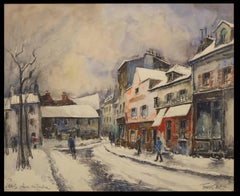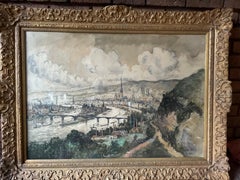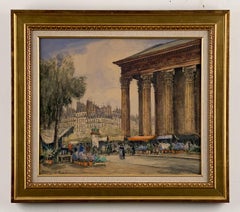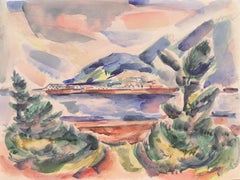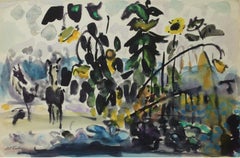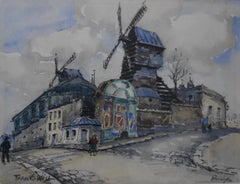Frank Will Landscape Drawings and Watercolors
French, 1900-1951
Frank-Will (1900-1951 Fr.) is the son of the American painter Frank Myers Boggs who was born out of wedlock while his father was living in France. His name Frank was taken from his father and Will from his grandfather. His military service during the war had the job of painting ambulances and other vehicles and was a true bohemian living in Montmartre attending all the local dance halls and a close friend of Gen Paul.to
1
1
1
Overall Width
to
Overall Height
to
3
1
1
2
1
3
2
1
1
1
1
1
3
3
1
1
4
143
125
79
63
1
2
1
Artist: Frank Will
La place du Tertre
By Frank Will
Located in Paris, FR
Frank Will
1900-1951 French
La Place du Tertre
Watercolor on vellum paper
Signed lower right and titled lower left
Paper: 19 1/2" high x 24" wide
Fr...
Category
Early 20th Century Post-Impressionist Frank Will Landscape Drawings and Watercolors
Materials
Watercolor, Vellum
Rouen
By Frank Will
Located in New York, NY
"Rouen" is a watercolor by Frank- Will , it is extremely large in size and from an important place in the history of France. This is where the tower of Joan of Arc is located and wh...
Category
1920s Impressionist Frank Will Landscape Drawings and Watercolors
Materials
Watercolor
Place de la Madeleine
By Frank Will
Located in Sheffield, MA
Frank Will
French 1900-1950
Place de la Madeleine
Watercolor on paper
18 by 21 in. w/frame 25 by 27 in.
Signed lower left
Son of painter Frank Myers Boggs. A Figure from montmatr...
Category
1930s Post-Impressionist Frank Will Landscape Drawings and Watercolors
Materials
Watercolor
Related Items
'Oregon Coast', Art Institute of Chicago, AIC, Works Project Association, WPA
Located in Santa Cruz, CA
Signed lower left, 'A. Vincent' for Andrew McDuffie Vincent (American, 1898-1993); inscribed verso with title, 'Oregon Coast' and dated 1945.
A vibrant w...
Category
1940s Post-Impressionist Frank Will Landscape Drawings and Watercolors
Materials
Watercolor, Paper
Sunflowers and Horses in Field, 20th Century Landscape Watercolor
By Joseph O'Sickey
Located in Beachwood, OH
Work sold to benefit the CLEVELAND INSTITUTE OF ART
Joseph B. O’Sickey (American, 1918–2013)
Sunflowers in Field
Watercolor on paper
Signed lower left
12.5. ...
Category
Late 20th Century Post-Impressionist Frank Will Landscape Drawings and Watercolors
Materials
Watercolor
'Tropical Lagoon', Impressionist Landscape with Palm Trees and Bougainvillea
Located in Santa Cruz, CA
Signed lower center, 'B. Metcalf'; additionally signed verso and painted circa 1975.
An idyllic tropical landscape showing palm trees and scarlet bougainvillea in the foreground wit...
Category
1970s Post-Impressionist Frank Will Landscape Drawings and Watercolors
Materials
Watercolor, Laid Paper
'French Courtyard', Large School of Paris Drawing, Ecole des Beaux Arts, Lyon
By Denis Paul Noyer
Located in Santa Cruz, CA
Signed lower left, 'Denis Paul Noyer' (French, b. 1940) and created circa 1975.
An exceptionally finely-detailed, silver point and colored pencil drawing showing a view of a Parisia...
Category
1960s Post-Impressionist Frank Will Landscape Drawings and Watercolors
Materials
Metal
'Rainy Day, Pool and Billiards', Laguna Beach Art Association, Solvang, Moure
Located in Santa Cruz, CA
Signed lower left, 'Marshall Thomas' for Marshall F. Thomas, (American, 1916-2011), and painted circa 1945.
An elegantly composed and atmospheric view of a California Main Street sh...
Category
1940s Post-Impressionist Frank Will Landscape Drawings and Watercolors
Materials
Paper, Watercolor, Gouache
“Strolling along the Seine, Paris”
By Guy de Neyrac
Located in Southampton, NY
The artwork is double matted with an antique style contemporary gold leaf gallery frame in fine condition. Overall framed measurements are 24 by 31 inches. Provenance: A Sarasota, Florida collector.
Guy de Neyrac was born in France in 1900 and is widely known for his impressionistic watercolor and pen drawings of Paris...
Category
1940s Post-Impressionist Frank Will Landscape Drawings and Watercolors
Materials
Ink, Watercolor, Archival Paper
"Icy Pond" Winter Landscape
By Grace Eichholz
Located in Soquel, CA
Serene winter landscape by Grace Eichholz (American, b. 1927). Signed "G. EICHHOLZ" in the lower left corner. Artist info and title on verso. Presented in a double mat of cream and w...
Category
Late 20th Century American Impressionist Frank Will Landscape Drawings and Watercolors
Materials
Paper, Watercolor, Pen
Oriental Landscapes With Palm Trees And Arab Houses. 1 Half Of The 20th Century.
Located in Firenze, IT
Fauve landscape with palm trees and Arab houses.
1 half of the 20th century.
Gouache paintings on cardboard.
Paintings is signed with monogram.
Dimensions with Passepartout 45.5cm x ...
Category
Early 20th Century Fauvist Frank Will Landscape Drawings and Watercolors
Materials
Paper, Watercolor, Gouache, Cardboard
H 14.57 in W 17.92 in
“Arc de Triomphe Paris”
By Henri Grenier
Located in Southampton, NY
Watercolor and gouache on archival paper by French artist, Henri Grenier. Signed lower right. Circa 1925. Condition is excellent. The artwork is housed in its original ornate carv...
Category
1920s Fauvist Frank Will Landscape Drawings and Watercolors
Materials
Oil Pastel, Archival Paper, Watercolor
Beneath the Birch Drawing by Swedish Artist Christian Berg (1893–1976)
Located in Stockholm, SE
We are proud to present an exquisite drawing by the renowned artist Christian Berg (1893-1976), executed around the 1920s. This captivating artwork port...
Category
1920s Naturalistic Frank Will Landscape Drawings and Watercolors
Materials
Watercolor, Board, Pencil
'Basilica di Santa Maria della Salute, Venice', Venetian Vedute, Grand Canal
Located in Santa Cruz, CA
Signed lower right, 'Danail Ochkov' (Bulgarian-American, born 1977) and dated 2003.
Born in Bulgaria, Danail Ochkov studied fine art at St. Cyril and St. Methodius University in Sof...
Category
Early 2000s Post-Impressionist Frank Will Landscape Drawings and Watercolors
Materials
Watercolor, Postcard
H 12 in W 14.75 in D 0.13 in
“Birches in Winter”
By Francis Stillwell Dixon
Located in Southampton, NY
Original watercolor and gouache on archival paper of birch trees in winter along a fenced roadway with a quaint home in the background. Signed lower right. Condition is excellent. Circa 1960. The watercolor is in a solid mahogany frame under UV glass in fine condition. Overall framed measurements are 14 by 11 inches. Provenance: A East Hampton, Long Island, New York collector.
Born in Queens, Long Island, NY, Impressionist
landscape and seascape painter Francis Dixon studied at the Art Students League in New York City under Impressionists Frank Vincent DuMond, Cape Cod, Massachusetts artist, Charles W. Hawthorne, and modernist Robert Henri. Having a good singing voice Dixon was an Army and Navy Song Leader for the War Department during World War I. From 1915 to 1917 was living and painting in Los Angeles, Carmel and Point Lobos, California. Dixon exhibited his California paintings at Folson Galleries New York City in 1917. Dixon continued to travel and paint, visiting Bermuda in 1923 and 1925, and Europe in the mid-1920s. In the 1930s he was living on West 55th Street in Manhattan with a number of other artists. He was a member of the Allied Artists of America (NY); Connecticut Academy of Fine Arts; and the Salmagundi Club, NY. He exhibited at The Corcoran Gallery of Art, Washington, D.C. (1916); Folson Gallery (NY, 1917, solo); Society of Independent Artists (NYC, 1917-18, 1920-22, 1924); Salmagundi Club (NYC, 1917-1940, 1943, 1945); National Academy of Design (NYC, 1925); Studio Guild Galleries (NYC, 1937); Barbizon-Plaza Galleries NYC, 1939); Allied Artists of America (NYC, 1940); and Salons of America (NYC). Dixon’s solo exhibitions included Babcock Galleries (NYC, 1926 and 1927); Women's University Club...
Category
1950s Post-Impressionist Frank Will Landscape Drawings and Watercolors
Materials
Watercolor, Gouache, Archival Paper
Previously Available Items
Frank-Will (1900-1950) Le Moulin de la Galette, Montmartre, Paris, Watercolor
By Frank Will
Located in Paris, FR
Frank-Will (1900-1950)
Le Moulin de la Galette, Montmartre, Paris,
Watercolor on paper.
Signed on the lower left,
18 x 24 cm
Framed : 35 x 41 cm
Le Moulin de La Galette is the se...
Category
1930s Post-Impressionist Frank Will Landscape Drawings and Watercolors
Materials
Watercolor
Frank Will landscape drawings and watercolors for sale on 1stDibs.
Find a wide variety of authentic Frank Will landscape drawings and watercolors available for sale on 1stDibs. You can also browse by medium to find art by Frank Will in paint, watercolor, paper and more. Much of the original work by this artist or collective was created during the 20th century and is mostly associated with the Post-Impressionist style. Not every interior allows for large Frank Will landscape drawings and watercolors, so small editions measuring 27 inches across are available. Customers who are interested in this artist might also find the work of Hughes Claude Pissarro, Paul Emile Pissarro, and Katherine Librowicz. Frank Will landscape drawings and watercolors prices can differ depending upon medium, time period and other attributes. On 1stDibs, the price for these items starts at $3,600 and tops out at $10,806, while the average work can sell for $7,000.
Artists Similar to Frank Will
Greta Allen
Questions About Frank Will Landscape Drawings and Watercolors
- Who is Frank Mariani?1 Answer1stDibs ExpertApril 5, 2024In the world of art, design and fashion, there are two answers to the question "Who is Frank Mariani?" because two people share that name in these fields. One is furniture designer Frank Mariani, who designed pieces for the Pace Collection, a manufacturer of high-end furniture. There is also the Beverly Hills-based tailor Frank Mariani, who designed suits for Ronald Reagan and a host of celebrities, including Bob Hope, Jimmy Stewart and Henry Fonda. Shop a collection of Frank Mariani furniture on 1stDibs.
- Who was Frank Stella's father?1 Answer1stDibs ExpertOctober 24, 2024Frank Stella's father was also named Frank. Although he worked as a gynecologist, the elder Frank Stella was an art lover and fostered his son's love of painting. Stella's mother, Constance, attended art school and was a landscape painter. On 1stDibs, explore a variety of Frank Stella art from some of the world's top galleries and dealers.
- 1stDibs ExpertOctober 24, 2024Frank Stella's nationality was American. He was born in Malden, Massachusetts, in 1936. Although his parents were also born in the U.S., all four of his grandparents were natives of Italy who immigrated to the country. Stella attended Phillips Academy in Andover, earned a BA from Princeton University and, in 1958, relocated to New York City. He remained there for much of his life and died there in 2024. On 1stDibs, shop a collection of Frank Stella art.
- What is Frank Auerbach style?1 Answer1stDibs ExpertApril 5, 2022Frank Auerbach is a figure painter whose work has been described as expressionist, however, he more accurately fits into the neo-expressionist classification. He’s also been known for creating semi-abstract portraits, which puts him more accurately in the modern art movement. On 1stDibs, find a variety of original artwork from top artists.
- 1stDibs ExpertAugust 29, 2024Frank Stella's philosophy, self-described as "what you see is what you see," reflects his belief that art shouldn't be representational and that its merit was in its actual form and not in any meaning that was assigned to it. He considered paintings on canvas to be objects in their own right, like sculptures, rather than representations. This led him to reject certain formal conventions, eschewing sketches and often using nontraditional materials, like house paint. Shop a range of Frank Stella art on 1stDibs.
- Why is Frank Stella important?1 Answer1stDibs ExpertNovember 20, 2024Frank Stella is important because he was one of the central figures in postwar American art and influenced later artists as a proponent of minimalism and non-representational abstraction. Stella felt that paintings on canvas were objects in their own right, like sculptures. This led him to reject certain formal conventions, eschewing sketches and often using nontraditional materials, like house paint. His approach to art impacted the work of Clement Greenberg, Carl Andre, Kenneth Noland and many others. Find a collection of Frank Stella art on 1stDibs.
- 1stDibs ExpertAugust 29, 2024Frank Stella was famous for his work as an artist. He was one of the central figures in postwar American art. A proponent of Minimalism and non-representational abstraction, Stella was a painter, printmaker and sculptor. Some of his best-known works include Shoubeegi, Harran II and The Marriage of Reason and Squalor II. Find an assortment of Frank Stella art on 1stDibs.
- Why is Frank Stella famous?1 Answer1stDibs ExpertOctober 24, 2024Frank Stella is famous for his work as an artist. He was one of the central figures in postwar American art. A proponent of Minimalism and non-representational abstraction, Stella was a painter, printmaker and sculptor. His work is in the collections of numerous major museums around the world, including New York’s Museum of Modern Art and Metropolitan Museum of Art; the Menil Collection in Houston; the Hirshhorn Museum and Sculpture Garden in Washington, D.C. and the San Francisco Museum of Modern Art. He was awarded the National Medal of Arts by President Obama in 2009 and was given the Lifetime Achievement Award in Contemporary Sculpture by the International Sculpture Center in 2011. He died on May 4, 2024. Some of his best-known works include Harran II, Shoubeegi and “The Marriage of Reason and Squalor” series. On 1stDibs, shop a selection of Frank Stella art.
- 1stDibs ExpertAugust 29, 2024Frank Stella influenced art by encouraging the spread of Minimalism, an extreme form of abstraction that focuses on forms rather than meaning. Through his work, Stella challenged the notion that art must be a representation of something else. He believed that the art itself was the only true meaning of a piece. His philosophy influenced other artists and architects, such as Frank Gehry, Timothy App and Carl Andre. On 1stDibs, shop a range of Frank Stella art.
- 1stDibs ExpertFebruary 1, 2024The style of Frank Lloyd Wright’s work is Prairie style. The architect pioneered the style, which draws inspiration from the natural beauty of the landscapes of the Midwest region of the U.S. Wright's design philosophy emphasized organic architecture, with buildings existing in harmony with their natural surroundings. His approach to architectural design had a profound influence on the shape of modern life, both while he was actively designing buildings and during the decades that followed. Shop a diverse assortment of Frank Lloyd Wright furniture on 1stDibs.
- 1stDibs ExpertApril 5, 2022Frank Lloyd Wright broke away from Victorian-era architecture and created “Prairie-Style” out of the belief that there should be fewer, larger rooms that flowed easily. He was also a key player in the Art Deco movement. Shop a collection of expertly vetted Frank Lloyd Wright pieces from some of the world’s top sellers on 1stDibs.
- 1stDibs ExpertFebruary 27, 2024The name of Frank Gehry's chair depends on which piece you're referring to, as the designer has produced quite a few chairs over the course of his career. Arguably, his most famous chair is the S-shaped Wiggle chair, crafted out of corrugated cardboard. He also designed several chairs out of ribbon-like pieces of bent wood, such as the armless, low-backed Hat Trick chair, the curvy Cross Check chair and the tall High Sticking chair. On 1stDibs, find a collection of vintage Frank Gehry chairs.
- 1stDibs ExpertMarch 15, 2024A painter is the type of artist that Frank Bowling is. He is generally considered to be an Abstract Expressionist, and he tends to incorporate themes and symbols inspired by his Guyanese heritage. Some of his best-known works include Who's Afraid of Barney Newman, Spreadout Ron Kitaj, Middle Passage, Sacha Jason Guyana Dreams, Pondlife, Late Blue and Blue Trane. On 1stDibs, shop a range of Frank Bowling art.
- 1stDibs ExpertOctober 15, 2024You can see Frank Stella art at a number of museums. Some institutions in the U.S. that have Stella pieces in their permanent collections include the San Francisco Museum of Modern Art in San Francisco, California; the Museum of Modern Art (MoMA) in New York City, New York and the Chrysler Museum of Art in Norfolk, Virginia. In addition, museums may host temporary exhibitions of the artist's work. On 1stDibs, find a selection of Frank Stella art.
- 1stDibs ExpertOctober 24, 2024Frank Stella went to college at Princeton University, earning a bachelor of arts from the institution. While there, he studied art and color theory with Josef Albers and Hans Hofmann. Stella frequented New York galleries as a student and was intrigued by the work of Jackson Pollock and Franz Kline, both of whom were at the height of their creative powers in the late 1950s. After moving to New York in 1958, Stella gravitated toward the geometric abstraction and restrained painting style of Barnett Newman and Jasper Johns. On 1stDibs, shop a collection of Frank Stella art.
- 1stDibs ExpertOctober 24, 2024Frank Stella used a variety of techniques. The American artist eschewed sketches for his paintings and often used nontraditional materials, like house paint. In 1960, he began introducing color into his work and using unconventionally shaped canvases to complement his compositions. Following a solo show at the Museum of Modern Art in New York in 1970, Stella began working in three dimensions, adding relief elements to paintings, which could be considered wall-mounted sculptures. Stella’s 1970–73 “Polish Village” series was inspired by documentary photographs and architectural drawings of Polish synagogues that had been destroyed by the Nazis during World War II. The resulting works — composed primarily of paint and cloth on plywood — are more rugged and less polished than his previous series. Herman Melville's Moby-Dick was Stella's muse for a series of three-dimensional works he created in the 1980s in which waveforms, architectural elements and Platonic solids played a prominent role. During this period, Stella embraced a new, exuberant style exemplified in his piece La Scienza della Fiacca. In addition to paintings and sculptural works, the artist also produced prints using lithography, serigraphy, etching and offset lithography techniques. Explore an assortment of Frank Stella art on 1stDibs.
- 1stDibs ExpertOctober 24, 2024Frank Stella made Harran II because of his interest in moving his work away from representation toward minimalist abstractions. He believed paintings on canvas were objects in their own right, like sculptures, rather than symbols for something else. Harran II was a part of Stella's Protractor series, characterized by colorful circles and arcs. Named after the ancient cities whose circular plans Stella had noticed while traveling in the Middle East during the 1960s, these works usually comprise several canvases set flush against one another so that the geometric figures in each section come together in a larger, more complex whole. In the case of Harran II, the name is a nod to a city in Turkey where Stella was inspired by intricate, colorful tile mosaics. Find a variety of Frank Stella art on 1stDibs.
- 1stDibs ExpertFebruary 27, 2024The material used in Frank Gehry's Wiggle chair is the type of corrugated cardboard that is typically reserved for making architectural models. The piece comes from Gehry's Easy Edges collection of paper furniture. Gehry was inspired to produce the Wiggle chair and the rest of his Easy Edges pieces because he believed that the seating options available to consumers when the chair debuted in 1972 were too expensive. Find a selection of vintage Frank Gehry furniture on 1stDibs.
- 1stDibs ExpertFebruary 27, 2024Frank Lloyd Wright used a variety of materials. For his homes and commercial buildings, the American architect favored natural materials and obtained them from local sources whenever possible. Some materials commonly featured in Wright's buildings include concrete, zinc, glass bricks, stone and wood. Wright’s wooden chairs and tables for his “Prairie Houses” of the early 1900s have sleek, attenuated forms, influenced by both the simplicity of traditional Japanese design and the work of Gustav Stickley and other designers of the Arts and Crafts movement. His desks and chairs for Johnson Wax have a streamlined look and feature tubular steel. Shop a variety of Frank Lloyd Wright furniture on 1stDibs.
- 1stDibs ExpertFebruary 27, 2024Frank Lloyd Wright's most famous house is arguably in Mill Run, a small community located in the Laurel Highlands region of southwestern Pennsylvania. Wright designed the home, called Fallingwater, in 1935 for the Kaufman family, who founded and owned a department store chain. Located around 70 miles southeast of Pittsburgh, the home is now open for daily tours. Just 7 miles away from Fallingwater is a second Frank Lloyd Wright home, Kentuck Knob. Designed in 1954, it was formerly the home of the Hagan family, who were friends with the Kaufmans. Explore a range of Frank Lloyd Wright furniture on 1stDibs.
